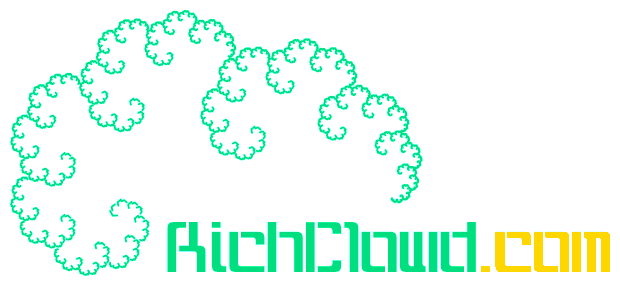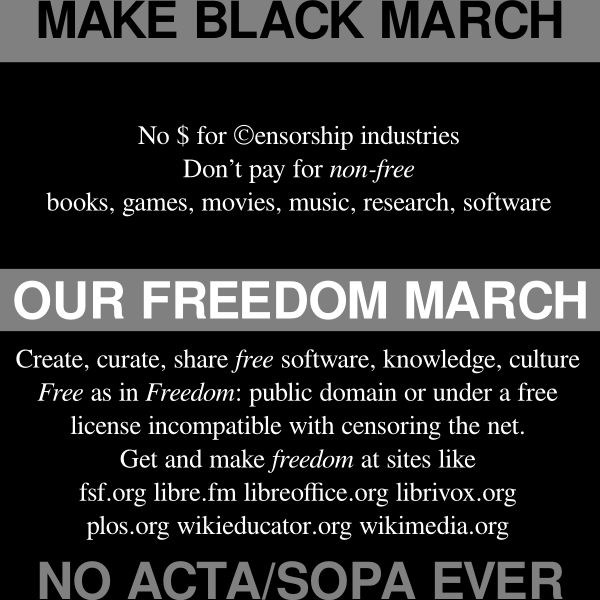Copyleft as a pro-software-freedom regulatory mechanism, of which more are needed.
Existing copyleft licenses include conditions that would not exist (unless otherwise implemented) if copyright were abolished. In other words, copyleft does not merely neutralize copyright. But I occasionally1 see claims that copyleft merely neutralizes copyright.
A copyleft license which only neutralized copyright would remove all copyright restrictions on only one condition: that works building upon a copyleft licensed work (usually as “adaptations” or “derivative works”, though other scopes are possible) be released under terms granting the same freedoms. Existing copyleft licenses have additional conditions. Here is a summary of some of those added by the most important (and some not so important) copyleft licenses:
| License |
Provide modifiable form2 |
Limit DRM |
Attribution |
Notify upstream3 |
| BY-SA |
|
y |
y |
|
| FDL |
y |
y |
y |
|
| EPL |
y |
|
y |
|
| EUPL |
y |
|
y |
|
| GPL (including LGPL and AGPL) |
y |
|
y |
|
| LAL |
|
|
y |
|
| MPL (and derivatives) |
y |
|
y |
|
| ODbL |
y |
y |
y |
|
| OFL |
|
|
y |
|
| OSL |
y |
|
y |
|
| OHL |
y |
|
y |
y |
I’ve read each of the above licenses at some point, but could easily misremember or misunderstand; please correct me.
There’s a lot more variation among them than is captured above, including how each condition is implemented. But my point is just that these coarse conditions would not be present in a purely copyright neutralizing license. To answer two obvious objections: “attribution”4 in each license above goes beyond the bare minimum license notice that would be required to satisfy the condition of releasing under sufficient terms, and “limit DRM” refers only to conditions prohibiting DRM or requiring parallel distribution (which all of those requiring modifiable form do in a way, indirectly; I’ve only called out those that explicitly mention DRM), not permissions5 granted to circumvent.
I’m not sure there’s a source for the idea that copyleft only neutralizes copyright. Probably it is just an intuitive reading of the term that has been arrived at independently many times. The English Wikipedia article on copyleft doesn’t mention it, and probably more to the point, none of the main FSF articles on copyleft do either. The last includes the following:
Proprietary software developers use copyright to take away the users’ freedom; we use copyright to guarantee their freedom. That’s why we reverse the name, changing “copyright†into “copyleft.â€
Copyleft is a way of using of the copyright on the program. It doesn’t mean abandoning the copyright; in fact, doing so would make copyleft impossible. The “left†in “copyleft†is not a reference to the verb “to leaveâ€â€”only to the direction which is the inverse of “rightâ€.
Copyleft is a general concept, and you can’t use a general concept directly; you can only use a specific implementation of the concept.
This is very clear — the point of copyleft is to promote and protect (“guarantee” is an exaggeration) users’ freedom, and that includes their access to source. The major reason I like to frame copyleft as regulation6 is that if access to source is important to software freedom (or otherwise socially valuable), it probably makes sense to look for additional regulatory mechanisms which might (and appreciate ones that do) contribute to promoting and protecting access to source, as well as other aspects of software freedom. Such mechanisms mostly aren’t/wouldn’t be “copyleft” (though at this point, some of them would simply mandate a copyleft license), but the point is not a relationship with copyright, but promoting and protecting software freedom.
If software freedom is important, surely it makes sense to look for additional mechanisms to promote and protect it. As others have said, licenses are difficult to enforce and/or few people are interested in doing it, and copyleft can be made irrelevant through independent non-copyleft implementation, given enough desire and resources (which the largest corporations have), not to mention the vast universe of cases in which there is no free software alternative, copyleft or not. I leave description and speculation about such mechanisms for a future post.
1For example, yesterday Rob Myers wrote:
Copyleft is a general neutralization of copyright (rather than a local neutralization, like permissive licences). Nothing more.
Only slightly more ambiguously, late last year Jason Self wrote:
Copyright gives power to restrict what other people can do with their own copies of things. Copyleft is about restoring those rights: It takes this oppressive law, which normally restricts people and takes their rights away, and make those rights inalienable.
Well said…but not exactly. I point these out merely as examples, not to make fun of Myers, who is one of the sharpest libre thinkers there is, or Self, who as far as I can tell is an excellent free software advocate.
2Note it is possible to have copyleft that doesn’t require source. As far as I know, such only exists in licenses not intended for software. But I think source for non-software is very interesting. The other obvious permutations — a copyleft license for software that does not include a source requirement, and a non-copyleft license that does include a source requirement, are curiosities that do not seem to exist at all — probably for the better, although one can imagine questionable use cases (e.g., self-modifying object code and transparency as only objective).
3As I’ve mentioned previously, requiring upstream notification likely makes the TAPR OHL non-free/open. But I list the license and condition here because it is an interesting regulation.
4One could further object that one ought to consider so-called “economic” and “moral” aspects of copyright separately, and only neutralize the former; attribution perhaps being the best known and least problematic of the former.
5Although existing copyleft licenses don’t only neutralize restrictions (one that did would be another curiosity; perhaps the License Art Libre/Free Art License currently comes closest), it is important that copyright and other restrictions are adequately neutralized — in particular modern public software licenses include patent grants, and GPLv3 permits DRM circumvention (made illegal by some copyright-related legislation such as the DMCA), while version 4.0 of CC licenses will probably grant permissions around “sui generis” restrictions on databases. Such neutralization is only counter-regulatory (if one sees copyright as a regulation), not pro-regulatory, as are source and other conditions discussed above.
6Regulation in the broadest sense, including at a minimum typical “government” and “market” regulation, as I’ve said before. By the way, it could be said that those who advocate only permissive licenses are anti-regulatory, and I imagine that if lots of people thought about copyleft as regulation, this claim would be made — but it would be a problematic claim, as permissive licenses don’t do much (or only do so “locally”, as Myers obliquely put it in the quote above) against the background regulation of copyright restrictions.



